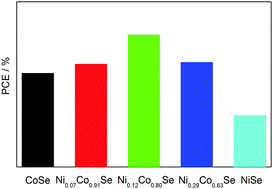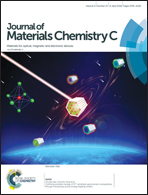Controllable growth of NixCoySe films and the influence of composition on the photovoltaic performance of quasi-solid-state dye-sensitized solar cells†
Abstract
Herein, ternary nickel cobalt selenide (NixCoySe) films with controllable stoichiometric ratios were prepared in situ on a conductive substrate. When the total amounts of metal salts and selenium are kept constant, the stoichiometric ratio of NixCoySe nanoparticles in situ growing on the conductive substrate can be controlled by adjusting the feed ratios of metal salts in the reaction solution. When the in situ-grown NixCoySe films are directly used as counter electrodes of quasi-solid-state dye-sensitized solar cells (QSDSSCs), the electrocatalytic properties of NixCoySe and the corresponding photovoltaic performances depend on the Ni/Co molar ratio. The QSDSSC device with the Ni0.12Co0.80Se counter electrode achieves the best power conversion efficiency of 8.61% among those with the counter electrode at other stoichiometric ratios. Impressively, the ternary Ni0.12Co0.80Se is superior to the binary selenides and the Pt control in terms of both electrocatalytic activity and solar cell performance; this is attributed to the synergetic effect between nickel and cobalt atoms in the ternary compound.

- This article is part of the themed collection: 2018 Journal of Materials Chemistry C HOT Papers


 Please wait while we load your content...
Please wait while we load your content...